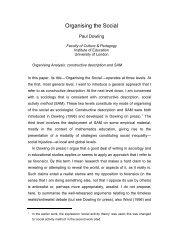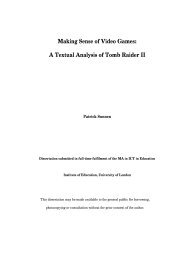Research and the Theoretical Field - Pauldowling.me
Research and the Theoretical Field - Pauldowling.me
Research and the Theoretical Field - Pauldowling.me
Create successful ePaper yourself
Turn your PDF publications into a flip-book with our unique Google optimized e-Paper software.
27<br />
organised as well-defined subjects, taught in specialised rooms, by specialist<br />
teachers <strong>and</strong> so forth; <strong>the</strong> English preparatory school would generally fit this<br />
bill. Bernstein (1977) referred to this kind of curriculum as operating on <strong>the</strong><br />
basis of a ‘collection code’—<strong>the</strong> student collected categories of knowledge, I<br />
suppose. On <strong>the</strong> o<strong>the</strong>r h<strong>and</strong>, it was supposed that <strong>the</strong> progressive English<br />
schools of <strong>the</strong> 1960s <strong>and</strong> 1970s often tended to avoid making sharp—if any—<br />
distinctions between school subjects, everything was done in <strong>the</strong> sa<strong>me</strong> room<br />
with <strong>the</strong> sa<strong>me</strong> teacher <strong>and</strong> so forth. Bernstein described this kind of curriculum<br />
as being organised according to a single integrating principle <strong>and</strong> so operating<br />
an ‘integrated code’.<br />
The work on codes—speech <strong>and</strong> curriculum—really provided <strong>the</strong> groundwork<br />
for two crucial categories that underpin all of Bernstein’s work. These<br />
categories have been described in different ways in Bernstein’s work <strong>and</strong> I’m<br />
going to simplify here. Essentially, <strong>the</strong>y mark a distinction between between<br />
<strong>and</strong> within. The category ‘classification’ (C) refers to <strong>the</strong> strength of insulation<br />
between categories, such as school subjects. The collection code can<br />
<strong>the</strong>refore be described as characterized by strong classification (C + ) <strong>and</strong> <strong>the</strong><br />
integrated code by weak classification (C - ). The category ‘framing’ refers to <strong>the</strong><br />
level of control imposed within categories. Again, Bernstein supposed that <strong>the</strong><br />
collection code school was also characterised by comparatively rigid<br />
sequencing <strong>and</strong> pacing <strong>and</strong> teacher control over what may count as legitimate<br />
knowledge—strong framing (F + ). The progressive school, he imagined would<br />
exhibit very weak control on sequencing, pacing or what may count as<br />
legitimate knowledge—weak framing (F - ). Thus <strong>the</strong> preparatory school<br />
curriculum—<strong>the</strong> collection code—is characterised as C + F + <strong>and</strong> <strong>the</strong> progressive<br />
school curriculum—<strong>the</strong> integrated code—as C - F - . Although Bernstein tended<br />
to make more use of C than F in his later work, <strong>the</strong>se two categories are<br />
certainly key to an underst<strong>and</strong>ing of his <strong>the</strong>ory <strong>and</strong> have been very important<br />
in a good deal of <strong>the</strong> research that has been infor<strong>me</strong>d by it (see, for example,<br />
Moore et al, 2006).<br />
Finally, I will <strong>me</strong>ntion Bernstein’s work on <strong>the</strong> constitution of pedagogic<br />
discourse (see Bernstein, 2000, for <strong>the</strong> mature version). Again, this is a <strong>the</strong><strong>me</strong><br />
that developed over many years in Bernstein’s work. I will not trace its history,<br />
but will simply sketch what Bernstein referred to as <strong>the</strong> ‘pedagogic device’.<br />
Drawing inspiration from Noam Chomsky’s ‘language acquisition device’,<br />
Bernstein posited <strong>the</strong> ‘pedagogic device’, which is to be understood as a social<br />
<strong>me</strong>chanism that deploys of principles of recontextualisation, distribution <strong>and</strong><br />
evaluation. The recontextualisation principles of <strong>the</strong> device regulate what <strong>and</strong><br />
how knowledge is recruited from <strong>the</strong> site of knowledge production—for<br />
example, in <strong>the</strong> university—<strong>and</strong> reconstituted as school knowledge as what he<br />
described as an ‘imaginary discourse’; school physics, in o<strong>the</strong>r words, is<br />
funda<strong>me</strong>ntally different from physics as practiced by academic physicists, not<br />
least because of <strong>the</strong> way in which <strong>the</strong> school curriculum, but not <strong>the</strong> professor,<br />
sequences <strong>and</strong> paces knowledge. School knowledge, fur<strong>the</strong>rmore, does not<br />
appear to all school students in <strong>the</strong> sa<strong>me</strong> form. Basically, students are<br />
differentiated according to categories such as ‘ability’, which, following a good<br />
deal of work in <strong>the</strong> sociology of education, often has a strong tendency to<br />
correlate with social class: note, here, that <strong>the</strong> early work on speech codes<br />
RESEARCH & THE THEORETICAL FIELD




